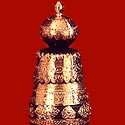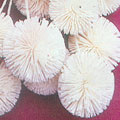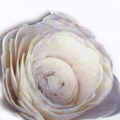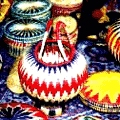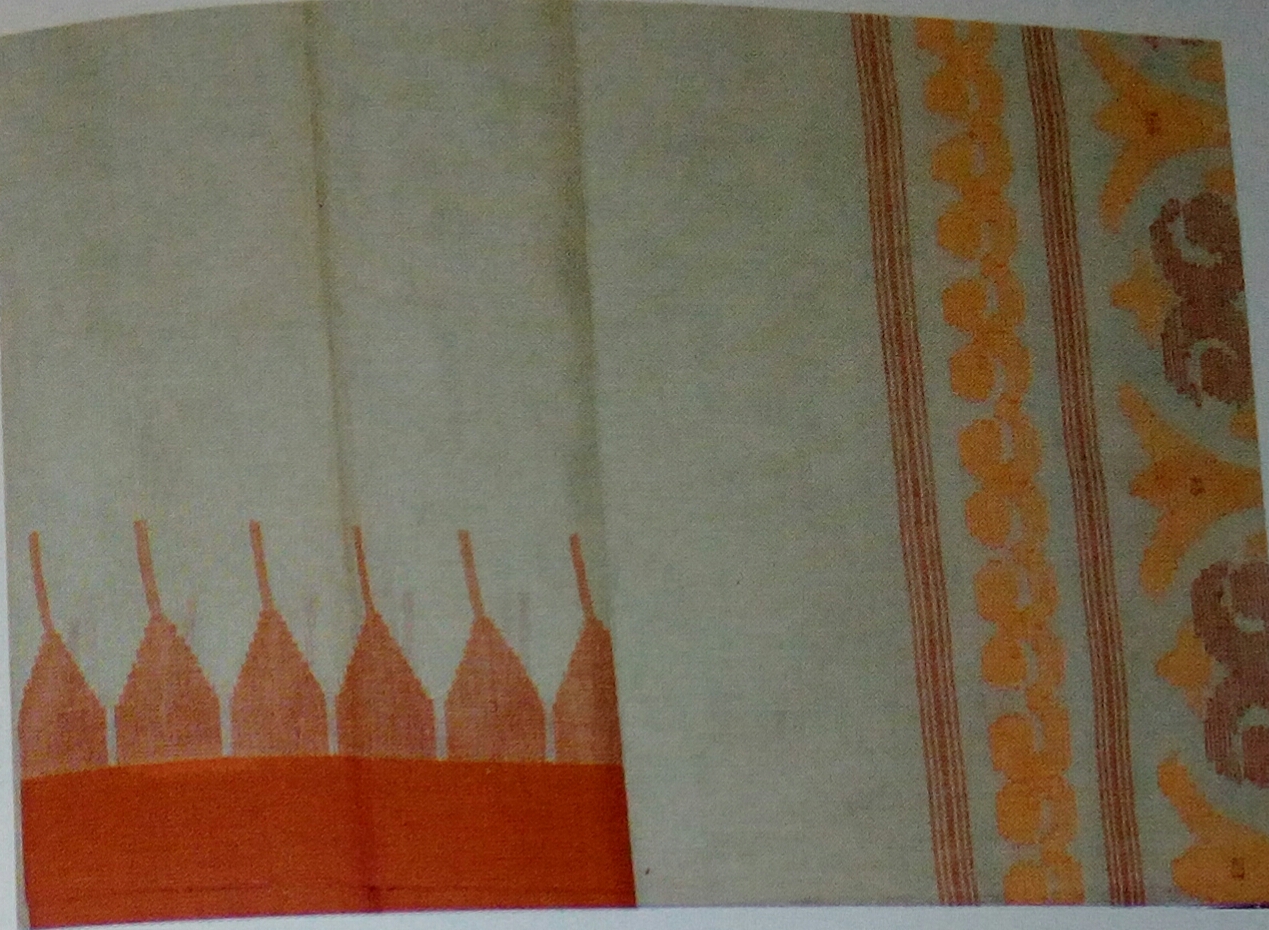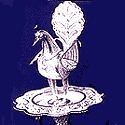Shell craft in many regions in India has a religious and social significance. The ornaments, decor and other elements made out of shells has a huge market in India. These ornaments are decorated with carvings, coloured with lacquer or inlaid with brands of gold and silver. The products crafted from the conch-shell include exquisite hair bands, bracelets, rings, lockets, pendants and amulets, ear rings and necklaces. Delicate bangles are also crafted from conch-shell and are essential part of a Hindu woman’s trousseau. These are embellished with notched edges or diamond shapes along the centre.
Generations of craftsmen have worked with shell - cleaning, polishing, cutting and fashioning the objects by hand made, with the use of simple tools - retaining the original shape and colour and creating objects of remarkable beauty often by juxtaposing different colours and shapes.
Sherpai, Kunke or bowls for measuring rice are only made in Lokepur near Siuri in Birbhum district. The word is derived from ser referring to a unit of weight and pau which means a quarter in Hindi. The wood of mango, palm, sirish or shishu trees is carved to make the bowls; these are then embellished with riveted sheet brass decoration. Earlier the form was achieved by carving and sculpting with hand. However today it is done so by turning the bowls on a lathe machine. The wood is coloured black with the help of a few herbs, which are soaked in water for two days. The brass sheets before being riveted on the bowl are embossed with various patterns and motifs. Traditionally a set of twelve bowls were made to be extensively used in the households of well-to-do farmers. Due to losing their traditional market, these bowls are now used only for decorative purposes, rather than being used for their intended use. The bowls are shaped in such a manner that they can be aesthetically arranged one on top of the other according to size. This craft is considered as one of the languishing crafts.
Making both ships and boats this craft tradition is an ancient one as it was the base of maritime trade given the long coastline of Kerala. The deep-bellied, strong ribbed ships built are spacious, fast and economical for carrying cargo as well as sufficiently durable to withstand the rough seas. Created in various shapes, styles and techniques to cater to a variety of needs the timber used for planks is from the branches of the modakku tree, which is known for its exceptional strength. The construction process begins with the joining of the stem posts to the front and rear of the keel; eight pairs of the ribs are laid out at different intervals on the keels and joined by planks at different heights to create the basic form of the hull. The additional ribs and planks, made of karimarathu and pilavu wood, are connected by thick planks using dovetail joints; these support the structure and the deck platform and also serve as a bracing. The wooden logs to be sawn into planks for ship building purposes are brought to the work site and placed on a platform made by wooden logs. For operating the saw, one craftsman climbs up on the platform while the other operates it from below. This is a highly skilled job, as the craftsmen have to maintain a regular thickness while cutting the planks. In order to form the ribs, the planks are first made flat on two surfaces by sawing; the curve is marked by chalk and the rib is cut according to the curve. After the ship is complete and the shed is dismantled, the entire inner side of the ship is washed and the dust and wooden particles are removed. The outside body of the ship is then washed with soap and water and special attention is given to the removal of fungal deposits that may have accumulated during the long course of the construction. The ship is allowed to dry and varnish is applied on the inside and the outside. The surface which will be submerged is coated with a paste of ghee, clarified butter, lime and oil, this mixture is reapplied after four years and later at intervals of six months. Ships and boats are produced in Beypore In Kozhikode district:
Among the traditional crafts, objects made from shoal are well known. In Bangladesh, this craft has been used to make wedding ornaments, toys for children, to decorate public places and also for the beautification of homes. Created by a community of artisans, known as Sholari or Malakars, the excellence of Dhaka craftsmanship is renowned as Dhakar shaj or Dhaker shaj a name by which it is still known. In fact Malitola, an area in old Dhaka, was named after the Malakars, a caste of shoal artisans, who lived there.

Shola pith is a milky-white sponge like core or pith of the shola stem which is carved into delicate and beautiful objects of art. This plant grows wild in marshy waterlogged areas. The outer harder brown skin is peeled to reveal the core which is approximately one and half inch in diameter. Some may say that this core resembles artificially produced "thermocol". However, shola pith is superior to thermocol in terms of malleability, texture, lustre and sponginess. During the time the Zamindari system was prevalent, the craft was restricted to only religious and ritualistic products like wedding headgear, flowers and garlands. Although once the zamindari system was abolished there was a remarkable growth in public Durga pujas, and a consequent growth in the demand for the shola pith products. Skilful hands craft artefacts used for decoration and ornate head-wears of bridal couple. The finest examples of craftsmanship are however seen on images of "Gods and Goddesses" on festivals, particularly the massive decorative backdrops made for "Durga Puja" celebrations. Craftsmen spend months working on each piece and every detail is meticulously worked out. Artisans practicing this craft, referred to as malakars, perform this simple process with great skill and a steady hand; which are the pre-requisites of the craft. The core which is obtained after removing the outer brown skin is sliced into strips, which are then shaped according to the artisan's imagination. In Murshidabad this shola pith craft is used to produce flowery designs, decorative head-wears of gods and goddesses, garlands, exquisite figurines like faces of gods and goddesses, elephant howdahs, peacock boats, palanquins and many more products.
Siddipet is the headquarters of the Siddipet district in Telangana. Siddipet Gollabama Sarees were originally woven with 60's–80’s cotton yarns for both the warp and weft. The border, body and pallu are embellished with extra weft “gollabama” (milkmaid) motifs and geometrical designs. These sarees are woven on pit and frame looms, using the traditional jala technique of weaving.
Sikki, the golden grass of Bihar, grows in the wet and marshy areas of Madhubani district. Meera Thakur, a skilled sikki artisan, and one who practises the craft as a profession, says that the grass is collected by harijans in savan (or the rainy season), and is dried by them before being sold. The grass is also sold by the traders at the weekly haat or market and by itinerant door-to-door sellers. The rate varies but interestingly, sikki is not sold by weight, but measured by the fist. A fistful comprises of between 30 and 35 split stalks and costs around Rs. 1.50. Meera learnt the craft form her mother, Gucchi Devi, who, in turn, learnt from her mother. Although Meera's father worked alongside her mother in making sikki products, this is dominantly a women's craft. Traditionally, and even now, sikki grass products are made by the women of the household, especially brides-to-be who take these products to their husbands' home(s) after marriage as part of their dowry. Sikki containers and boxes, filled with dry-fruits and auspicious commodities are also gifted to daughters at the time of marriage.
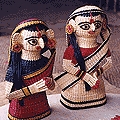


Varanasi is famous for its brocades and use of silk in multiple unimaginable ways. One of the many splendid wonders in the Jamdani textile. Jamdani was earlier woven in cotton. Then, with the popularity of silk, Jamdani silk weaving started to take place. Earlier, shuttle pit loom was used to weave silk sarees, but now power loom has made its niche. It is woven in pure silk, or with blend of silk with cotton, gold zari, metal yarn, etc. A variety of motifs are created in jamdani, namely Chameli (jasmine), Genda (marigold flower), Pan (betel leaf),etc.
Wangkhei Phee is a traditional product from Manipur. The method of weaving this fabric is simple, and the design is developed without using any implements like dobby or jacquard. The design is first painted on the warp and then, as per the contour of the design, extra weft yarn is interlaced with the warp to create the design. The process is labour intensive and time-consuming.
The strength of this plant is reflected in its local name of hattibar, or 'elephant fence. A member of the sisal (Agave) family, this is a perennial plant, which stands 1-2 m high. The fibre is extracted from the mature outer leaves that are cut. The fibres are extracted by retting and beating. The sisal is basically used for ropes and for the weaving of porters' headbands.
Velvet is woven on a special loom that weaves two thicknesses of the material at the same time. The two pieces are then cut apart to create the pile effect. This complicated process meant that velvet is expensive to make. Velvet can be made from either synthetic or natural fibres or a mix of these, the most expensive of which is silk. Much of the velvet available now is not made on handloom but made on machine.. Silk velvet making is rare and with its shiny sumptuous look and feel it is a luxury product when made on the handloom.
The main centres for this craft are Cuttack in Odisha and Karim Nagar in Andhra Pradesh. Traditionally the ingots were beaten on an anvil and elongated into long wire by passing them through a steel plate with apertures of different wire gauges. Each filigree jewellery piece actually combines several component parts.The space within the frame is filled with the main ribs of the pattern which is usually a creeper or flower, forming itself into small frames of circles, flower petals, and the like. Karim Nagar in Andhra Pradesh has long been noted for its silver filigree work. This traditional craft requires delicate workmanship. The products made include ashtrays, boxes, cigarette cases, trays, bowls, spoons, pill boxes, jewellery, buttons, paandans,, and perfume containers in the shape of peacocks, parrots, or fish. The jewellery made here has twisted silver wire as the base material; the articles have a lacy, trellis-like appearance which gives them a rare charm. Two or three wires are wound together after heating and then bent into various shapes to get patterns. The components are fixed together by a special method in which small square strips of an alloy of copper and silver known as tankam are spread to make the entire design, and then placed on the furnace. When well heated, dry paddy husk is sprinkled on it; this bursts into flames and melts the tankam pieces. The molten tankam penetrates into crevices and ensures the firm binding of the small pieces that comprise the whole. The block is then cooled in cold water. The smaller articles are directly moulded into various designs. For larger articles, smaller ones are made and pieced together. The main ribs are first fixed and the interstices are filled in with delicate tendrils or circular pieces which gives the article its special character. Karim Nagar has its own unique patterns and the elaboration in filigree is according to the pattern. A design with a high level of traceries is known as the Karim Nagar design. This is visible mainly in the perfume containers made in Karim Nagar, a product for which the place is famous.
Filigiri is an ancient art of crafting ornaments using very fine metal wires. This craft flourished under the patronage of kings and nawabs and was in popular use by the aristocrats of that time in India. Apart from jewellery, other ornamental crafts were produced using this technique. Idols of gods and goddesses, decorative animals and replicas of temples. Traditional items of utility lie betel nut boxes, sindoor containers and cutlery. Although post independence, there has been a gradual downfall in the practising of this craft, there are innumerable admirers of Filigiri work worldwide which are keeping the market alive. [gallery ids="176661,176662,176663,176664,176665,176667,176668,176669"]

